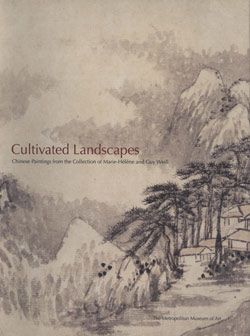The Strange Pines of Mount Tiantai
Dai Benxiao Chinese
Not on view
Having never visited Mount Tiantai, a Buddhist and Daoist refuge in Zhejiang Province, Dai Benxiao conjured this towering image from a combination of legends, other paintings, and his imagination. The mountain’s famous stone bridge—believed to be a link between this world and the paradise of the immortals—features prominently, but Dai tells us in the inscription that his true focus is the weathered pines that cling dramatically to the mountain’s cliffs.
Compare Dai’s approach to composition in this large hanging scroll with his two albums on the right. Here, Dai builds and blends twisting landscape forms to capture the majesty and complexity of the mountain within a single impressive vista. In the albums, he creates a journey through discrete vignettes, which are meant to be read on a table by a single viewer.
The strangely shaped pine trees of Mount Tiantai have been depicted by artists in the past. Lu Guimeng [of the Tang dynasty (618–907)] recorded and wrote a eulogy for one of these paintings. I have seen a copy of this painting at the home of a collector and was not impressed by it. Therefore I have decided to portray this theme by drawing upon my own imagination. I have heard recently that most of these strange pines have met the sad fate of extinction. It seems that once the natural wonders of the sky, earth, mountains, and rivers are exposed to the intimate scrutiny of the dusty world, they do not last long. This is indeed cause for lamentation. [Dai] Benxiao, Heavenly Root Gatherer of Mount Ying’a did this for the amusement of Jun, my elder brother in the Way. On the summer solstice of the dingmao year [1687].
—Trans. adapted from Dawn Delbanco
#7304. The Strange Pines of Mount Tiantai
Due to rights restrictions, this image cannot be enlarged, viewed at full screen, or downloaded.



